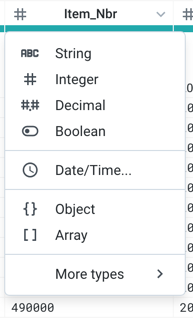Change Column Data Type
While transforming your data, you may need to change the data type of one or more columns. For example, data of String type may be the easiest to manipulate. Since there are no mismatched values for String data type, you may wish to change a column's data type to this baseline type.
Data types that you see in the Transformer page represent types that are understood by the product.
When data is imported from a separate datastore, Designer Cloud Powered by Trifacta Enterprise Edition may apply internal data types to the data. These types may differ from the original data typing in the source. As needed, the inferring of data types can be disabled at the file, connection, or global level. For more information, see Disable Type Inference.
When data is published from the product to a separate datastore, these types may be mapped to different data types in the target. For more information, see Type Conversions.
Tip
You can use the Change Column Type transformation to override the data type inferred for a column. However, if a new transformation step is added, the column data type is re-inferred, which may override your specific typing. You should consider applying Change Column Type transformations as late as possible in your recipes.
For more information on the available data types, see Supported Data Types.
Change Type
You can change a column's data type in one of the following ways:
Change Data Type for Multiple Columns
If you must change the data type for multiple columns to a single data type, you can use a transformation like the following, which changes the columns LastName, FirstName, and Address to String data type.
Transformation Name |
|
|---|---|
Parameter: Column 1 | LastName |
Parameter: Column 2 | FirstName |
Parameter: Column 3 | Address |
Parameter: New Type | String |
Note
When specifying a data type by name, you must use the internal value for the data type. The value in the column menu is the display name for the type.
For more information, see Valid Data Type Strings.
Change Datetime Data Type
If you are changing a column's data type to Datetime, you must also select a format string to apply to the column.
Via Transform Builder
In the Transformer Builder, you can apply a specific transformation to format one or more columns to Datetime data type, using a specific format.
Tip
You can use the following transformation to change the format of a Datetime column.
This transformation looks like the following:
Transformation Name |
|
|---|---|
Parameter: Columns | Multiple |
Parameter: Column 1 | myDate |
Parameter: New Type | Date/Time |
Parameter: Date/time Type | month*dd*yyyy*hh:MMaX |
For more information, see Datetime Data Type.
